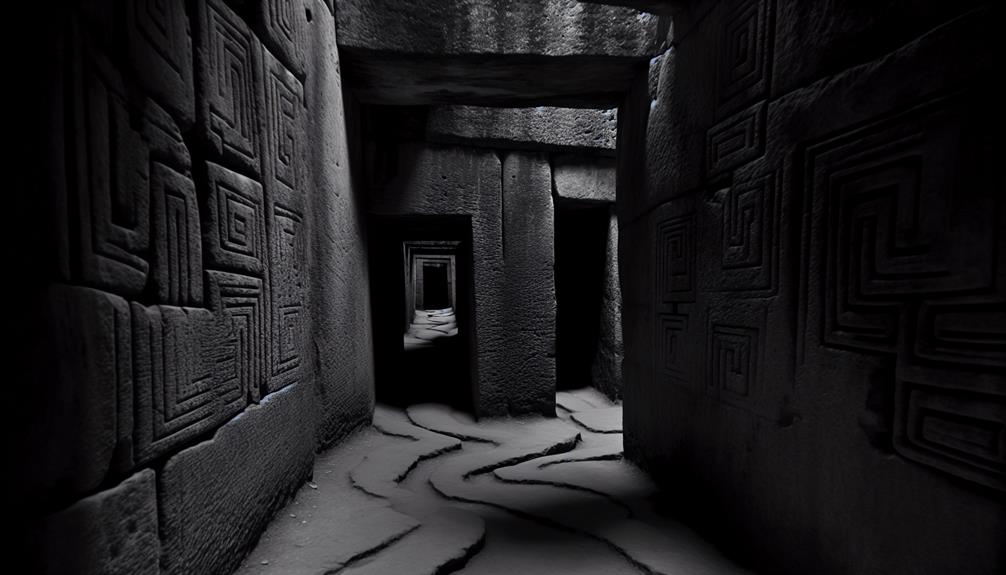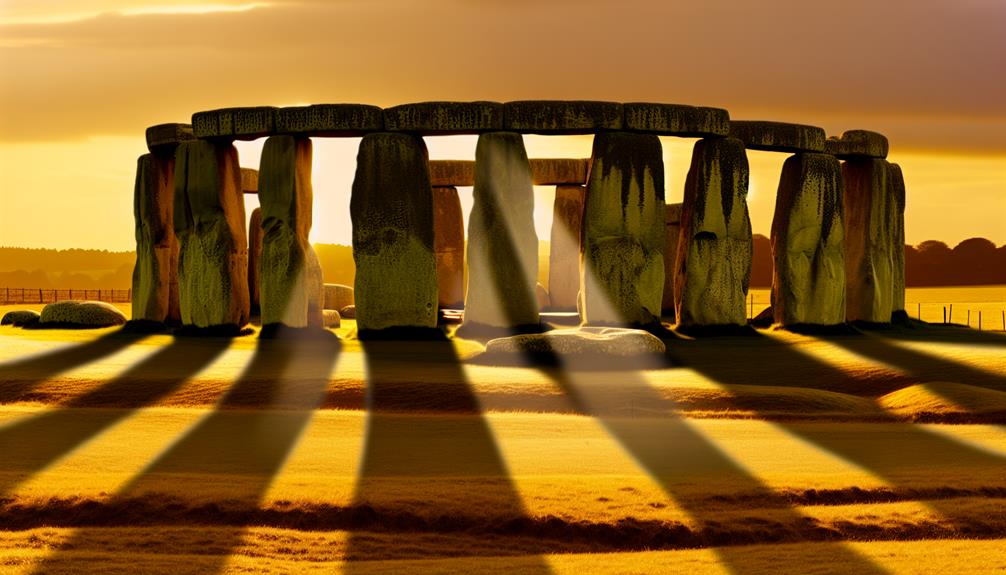Nestled on the island of Crete, the Minotaur's Labyrinth in Greece stands as a perplexing tribute to ancient Greek mythology and historical intrigue. As the shadowy corridors wind their way beneath King Minos' palace, one cannot help but ponder about the labyrinth's hidden chambers and the secrets they guard. Explore the depths of this enigmatic maze, where tales of heroism and treachery intertwine, inviting you to uncover the mysteries that lie within and discover the labyrinth's enduring legacy.
Key Takeaways
- The Minotaur's Labyrinth is a mythical structure in Crete linked to Greek mythology.
- It was designed by Daedalus beneath King Minos' palace, blending artistry and functionality.
- Theseus entered the labyrinth to slay the Minotaur, guided by Ariadne's thread.
- The purpose of the labyrinth remains enigmatic, possibly serving religious or astronomical functions.
- Modern explorations uncover artifacts and insights into the ancient Minoan civilization, deepening its allure.
Mythical Origins
Shrouded in the mists of ancient Greek mythology, the origins of the Minotaur and its labyrinth on the island of Crete have captivated scholars and storytellers for centuries. The Minotaur, a creature with the body of a man and the head of a bull, is a prominent figure in ancient legends. According to myth, King Minos of Crete commissioned the architect Daedalus to construct a labyrinth to contain the Minotaur, a punishment inflicted by the gods due to Minos' transgressions. The Minotaur, born from the union of Minos' wife Pasiphae and a divine bull sent by Poseidon, was said to be a fearsome beast that devoured human sacrifices sent as tribute from Athens.
Ancient legends further embellish the tale, recounting how the Athenian hero Theseus volunteered to slay the Minotaur and end the grisly tribute. Guided by Minos' daughter, Ariadne, who fell in love with him, Theseus navigated the labyrinth using a thread given by Ariadne to find his way back after defeating the Minotaur. This heroic feat became a symbol of courage and cunning in the face of monstrous adversaries, echoing through generations as a proof of the indomitable spirit of humanity in the face of mythical creatures and ancient legends.
Crete's Ancient Wonder
With its rich history and architectural marvels, Crete stands as an ancient wonder that continues to intrigue historians and visitors alike. Crete, the largest of the Greek islands, is steeped in historical significance and is home to numerous archaeological findings that shed light on its ancient past.
| Historical Significance | Archaeological Findings | Cultural Impact | Modern Tourism |
|---|---|---|---|
| Crete was the center of the Minoan civilization, Europe's first advanced civilization. | The Palace of Knossos, a vast archaeological site, provides insight into the Minoan culture. | The Minoan civilization influenced later Greek culture and mythology, leaving a lasting impact on art, architecture, and literature. | Crete's archaeological sites attract millions of tourists annually, seeking to explore the island's ancient wonders. |
The island's historical significance is unparalleled, as it was the center of the Minoan civilization, Europe's first advanced society. Archaeological findings such as the Palace of Knossos offer a glimpse into the sophisticated Minoan culture, showcasing advanced architectural techniques and artistic achievements.
The cultural impact of Crete is immense, with the Minoan civilization influencing later Greek culture and mythology. This influence is evident in various aspects of Greek art, architecture, and literature, highlighting the lasting legacy of Crete's ancient wonders.
Today, modern tourism thrives on the exploration of Crete's archaeological sites, attracting millions of visitors who seek to immerse themselves in the island's rich history and unravel the mysteries of its ancient past.
King Minos' Domain
King Minos ruled over a domain that fascinated both ancient inhabitants and modern historians with its intricate society and enigmatic legends. As the legendary king of Crete, Minos was not only known for his role in the myth of the Minotaur but also for his contributions to the flourishing Minoan civilization. At the heart of his domain was the grand palace at Knossos, a center of culture, trade, and governance that reflected the sophistication of Minoan society.
The palace of Knossos was not only a physical representation of King Minos' power but also a place steeped in mythological creatures and legends. According to the famous myth, Minos' wife Pasiphae gave birth to the Minotaur, a creature with the body of a man and the head of a bull, which was said to dwell within a labyrinth beneath the palace. This labyrinth, designed by the master craftsman Daedalus, became the setting for the tragic tale of Theseus and the Minotaur, adding to the mystique of King Minos' domain.
Through the intricate design of his palace and the intriguing legends surrounding his rule, King Minos left a lasting legacy that continues to fascinate scholars and visitors alike. His domain, with its blend of historical significance and mythological allure, remains a captivating aspect of ancient Greek history.
Daedalus' Intricate Design
Daedalus' meticulous and innovative architectural planning played a pivotal role in the construction of the labyrinth beneath King Minos' palace at Knossos, embodying a blend of artistry and functionality in its intricate design. The intricate craftsmanship displayed in the labyrinth's structure showcased Daedalus' unparalleled skill and creativity. Every twist and turn within the labyrinth was carefully calculated to confuse and disorient those who dared to enter, illustrating Daedalus' strategic approach to design.
Beyond its practical function, the labyrinth also held significant mythical symbolism. The complex network of passageways and dead-ends symbolized the unpredictability of life's journey, mirroring the twists and turns one must navigate in the face of adversity. Additionally, the labyrinth's construction highlighted Daedalus' desire to create a structure that transcended mere architectural significance, delving into the world of legend and myth.
Daedalus' intricate design not only served as a physical barrier to contain the Minotaur but also as a testament to his ingenuity and vision. The labyrinth stood as a tribute to the power of human creativity and the enduring legacy of those who dare to push the boundaries of conventional design.
Theseus and the Minotaur
In the heart of the labyrinth beneath King Minos' palace at Knossos, the legendary encounter between Theseus and the Minotaur unfolded amidst the intricate twists and turns devised by Daedalus' architectural ingenuity. Theseus, the courageous prince of Athens, ventured into the treacherous maze with a singular purpose: to end the Minotaur's reign of terror and free his people from the annual tribute of young lives. Armed with a sword given by his father Aegeus and guided by Ariadne's thread, Theseus navigated the labyrinth's complexity to face the monstrous half-bull, half-man creature at its heart.
- Symbol of Bravery: Theseus' victory over the Minotaur symbolizes the triumph of bravery and heroism in the face of seemingly insurmountable challenges.
- Ancient Mythology's Moral Lesson: The tale of Theseus and the Minotaur serves as a timeless lesson about the power of perseverance, strategy, and valor in overcoming adversity.
- Legacy of Freedom: The myth echoes the human desire for freedom from oppression and the belief that individuals, like Theseus, can defy fate and shape their own destinies.
This ancient myth of Theseus' daring quest and ultimate success against the monstrous Minotaur continues to captivate audiences, resonating with the universal themes of courage, sacrifice, and liberation found throughout human history.
Labyrinthine Mysteries Unveiled
The intricate design of the labyrinth beneath King Minos' palace at Knossos reveals a network of perplexing passageways and cryptic chambers, holding within its walls a tapestry of enigmatic mysteries waiting to be unraveled. This labyrinthine architecture, with its hidden secrets and ancient puzzles, has puzzled historians and archaeologists for centuries, adding to its historical significance.
The labyrinth's construction, believed to have been overseen by the legendary craftsman Daedalus, showcases a level of sophistication that defies the era in which it was built. The meandering corridors and intricate layout suggest a purpose beyond mere confinement of the Minotaur, hinting at a deeper, more symbolic significance. Some scholars speculate that the labyrinth may have served as a center for religious rites or even astronomical observations due to its alignment with celestial events.
Furthermore, the discovery of various artifacts within the labyrinth, including ornate pottery and intricate frescoes, adds another layer to its enigmatic aura. These remnants offer glimpses into the lives of the ancient Minoans and possibly hold clues to the labyrinth's true purpose.
As researchers continue to explore the labyrinth, its mysteries remain tantalizingly out of reach, inviting further speculation and analysis. The enigmatic nature of this ancient structure ensures that the labyrinth beneath Knossos will continue to captivate and mystify generations to come.
The Maze's Dark Chambers
Exploring the shadowy recesses of the labyrinth beneath Knossos reveals a network of dark chambers shrouded in mystery and intrigue. These chambers, filled with echoes of ancient myths and secrets waiting to be discovered, offer a glimpse into the fascinating world of ancient architecture and hidden passageways.
- Hidden Passageways: Within the dark chambers of the labyrinth, hidden passageways wind their way through the intricate maze, leading travelers deeper into the heart of the structure. These passageways, rumored to have been designed to confuse and disorient intruders, add an element of suspense to the already mysterious labyrinth.
- Ancient Myths: The dark chambers are steeped in ancient myths and legends, with whispers of the Minotaur and the brave heroes who dared to venture into its depths. These myths lend an air of mystique to the chambers, drawing visitors into a world where reality blends seamlessly with fiction.
- Secrets Revealed: As visitors navigate the labyrinthine chambers, secrets of the ancient architecture are gradually uncovered. The intricate designs, hidden symbols, and structural marvels provide insight into the advanced engineering and artistic prowess of the civilization that created this enigmatic maze.
In the dim light of the torches, the dark chambers of the labyrinth pulsate with history and intrigue, inviting intrepid explorers to unravel their secrets and explore the depths of a bygone era.
A Symbol of Power
Nestled within the dark chambers of the labyrinth beneath Knossos, the intricate design and symbolism of the structure emerge as a striking manifestation of ancient power and authority. The Minotaur's Labyrinth serves as a symbolic representation of the dominant rule and historical significance of the Minoan civilization, showcasing their control and influence over the people and lands they governed.
| Symbolism | Description |
|---|---|
| Elaborate Pathways | The complex network of corridors symbolizes the intricate nature of power. |
| Central Chamber | The heart of the labyrinth represents the seat of authority and control. |
| Minotaur Imagery | Depictions of the creature within the labyrinth signify strength and fear. |
The labyrinth's symbolism goes beyond mere architecture; it encapsulates the essence of power dynamics during ancient times. The deliberate construction of the maze with its twists and turns mirrors the complexities of leadership and governance. The central chamber, believed to be the Minotaur's dwelling, stands as a representation of the ruler's ability to instill fear and awe in their subjects. The imagery of the Minotaur itself, a creature of both human and beastly nature, embodies the duality of power – the ability to protect and provide, as well as to intimidate and destroy.
As visitors explore the labyrinth, they are transported back in time, experiencing firsthand the symbolic representation of authority and the historical significance embedded within its walls.
Modern-Day Exploration
Bearing witness to the remnants of the ancient labyrinth below Knossos, modern explorers investigate the enigmatic depths, uncovering layers of historical intrigue and cultural significance. These intrepid adventurers explore the heart of the Minotaur's Labyrinth, where echoes of the past reverberate through time, revealing secrets long forgotten.
- Archaeological Discoveries: Modern-day explorers meticulously unearth artifacts and structures that shed light on the ancient Minoan civilization, piecing together the puzzle of Crete's rich history.
- Hidden Secrets Revealed: With each excavation, hidden chambers and cryptic inscriptions come to light, offering tantalizing glimpses into the rituals and beliefs of a bygone era.
- Connection to Ancient Ruins: The exploration of the labyrinth intertwines with the exploration of nearby ruins, creating a tapestry of knowledge that links the past to the present, enriching our understanding of this enigmatic civilization.
As these daring individuals navigate the labyrinth's twists and turns, they not only decipher its physical layout but also unravel the symbolic significance it held for the ancient Greeks. Through their efforts, the modern world gains a deeper appreciation for the complexities of Minoan society and the enduring allure of myths and legends that continue to captivate us today.
Frequently Asked Questions
How Did the Minotaur's Diet Influence Its Behavior?
The influence of diet on behavior is a critical aspect of understanding any creature's actions. The minotaur's diet likely played a significant role in shaping its behavior, as food sources can impact an individual's aggression, social interactions, and overall well-being.
Analyzing the relationship between the minotaur's diet and behavior provides valuable insights into its biology and psychology, shedding light on the complex interplay between sustenance and actions in this mythical creature.
What Materials Were Used to Construct the Labyrinth Walls?
In ancient architecture, construction materials played a pivotal role in shaping the durability and aesthetics of monumental structures. The selection of materials like stone, clay, wood, and even metals for the walls of labyrinths showcased the craftsmanship and engineering prowess of civilizations.
These materials were expertly chosen to withstand the test of time and provide a formidable barrier, highlighting the intricate blend of artistry and practicality in architectural endeavors of antiquity.
Were There Any Secret Escape Routes in the Labyrinth?
Hidden passages were a common feature in ancient structures, aiding in various purposes such as quick exits or clandestine movements. The presence of such elements allowed for strategic advantages and contributed to the mystique of historical sites.
In mythological accounts, these secret escape routes often played a vital role in evading dangers posed by mythical creatures or enemies. Their existence showcases the ingenuity and resourcefulness of ancient civilizations in designing elaborate structures for protection and survival.
How Did the Minotaur's Roar Affect Those Inside the Maze?
The Minotaur's roar, a primal sound echoing through the maze, had a profound impact on those trapped within. The sheer intensity of fear instilled by the creature's bellow reverberated in the labyrinth's corridors, inducing panic and distress.
The psychological effects of such terror were debilitating, causing disorientation and clouding judgment. The roar served as a constant reminder of the imminent danger lurking within the labyrinth's walls, heightening the sense of dread and hopelessness among its captives.
What Role Did the Stars Play in the Labyrinth's Design?
Astronomical inspiration played a pivotal role in the labyrinth's design, guiding celestial navigation within its intricate layout.
The stars served as a guiding light, influencing the placement of corridors and chambers to align with celestial patterns.
This incorporation of astronomical elements not only added a mystical dimension to the labyrinth but also enhanced its functionality, aiding in navigation and orientation within the complex structure.
Conclusion
To sum up, the Minotaur's Labyrinth in Greece stands as a timeless enigma, a maze of intricacies reflecting the complexities of leadership and power in ancient times. Like a labyrinth of life, it symbolizes the journey of courage, sacrifice, and liberation, inviting us to navigate through the dark chambers of our own existence and unravel the mysteries that lie within.
Just as Theseus faced the Minotaur, we too must confront our inner demons to emerge victorious.


